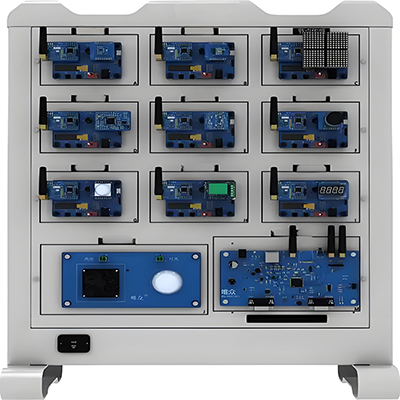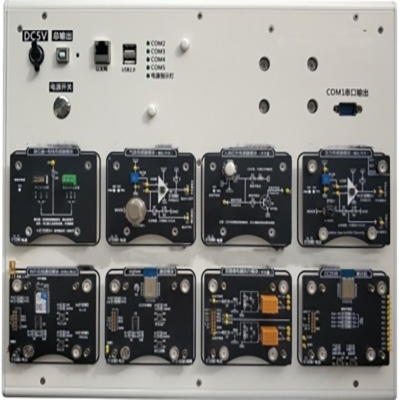GLW-2B Internet of Things training equipment is a teaching and training equipment for electronic information, computer and Internet of Things majors. It is mainly composed of sensor network application development training kit, sensor series kit, single-chip series kit, actuator series kit, automatic identification kit, computer, operation table, sensor network application development training kit wire package, switch, router, cloud platform, development tools and training guide. It is equipped with high-performance motherboard and expansion interface, and there are a variety of Internet of Things modules and sensor modules to choose from. Students can arbitrarily connect modules for experiments, complete the basic knowledge learning of Internet of Things and complex multi-module networking experiments.
GLW-2B Internet of Things training equipment
GLW-2B Internet of Things training equipment is a teaching and training equipment for electronic information, computer and Internet of Things majors. It is mainly composed of sensor network application development training kit, sensor series kit, single-chip series kit, actuator series kit, automatic identification kit, computer, operation table, sensor network application development training kit wire package, switch, router, cloud platform, development tools and training guide. It is equipped with high-performance motherboard and expansion interface, and there are a variety of Internet of Things modules and sensor modules to choose from. Students can arbitrarily connect modules for experiments, complete the basic knowledge of Internet of Things and complex multi-module networking experiments.
This training equipment is rich in resources and provides dozens of course experiments. It can complete the experimental training of many courses such as single-chip microcomputer technology, embedded system, RFID technology, ZigBee technology, radio frequency identification technology, wireless communication technology, Internet technology, sensor technology, data sub-application technology, etc. The course experiment provides open software and hardware resources, focusing on cultivating students' practical hands-on ability, and can realize teaching, scientific research, student graduation design and other related Internet of Things topics.
Ⅰ、Sensor Network Application Development Training Kit
(Ⅰ) Sensor Network Application Development Experimental Platform
1. This Internet of Things training equipment provides a variety of independent power output interfaces with different safety voltage levels;
2. In order to facilitate the operability of the experiment and the subsequent related technology upgrades, the platform and the module adopt a non-fixed magnetic suction connection method;
3. In order to ensure the compatibility of the IoT basic teaching sensor course, single-chip microcomputer course, and automatic identification course, the sensor series kit, single-chip microcomputer series kit, and automatic identification series kit can all be used for teaching and training on the sensor network application development experimental platform;
(Ⅱ) IoT cloud platform
1. It can realize home scene mode setting management, lighting system intelligent control, home environment intelligent control, intelligent security alarm and other functions;
2. It can log in to the cloud platform through PC, mobile smart terminal, smart gateway and other devices in the wide area network;
3. Support the configuration of the heartbeat polling time between the cloud platform and the gateway.
4. Support temperature, humidity, water temperature, carbon dioxide, light, wind speed, atmospheric pressure, air quality, combustible gas, flame, infrared radiation sensor, etc.;
5. Support manual and default IoT node configuration schemes.
(III) ZigBee coordinator module
1. Applicable to 2.4GHz, IEEE 802.15.4.ZigBee and RF4CE applications;
2. Support ZigBee2007/ ZigBee2007 PRO protocol;
(IV) Hardware part
1. ZigBee module
1) Applicable to 2.4GHz, IEEE 802.15.4.ZigBee and RF4CE applications;
2) Support ZigBee2007/ ZigBee2007 PRO protocol;
2. M3 master control module (CAN/485)
1) Support ISO international standardized serial communication protocol;
2) Connected to the physical bus through the CAN transceiver interface chip;
3) Transmission rate ≥10Mbps;
3. NB-IoT module
1) Built-in Cortex-M3 (32-bit), main frequency supports 32 kHz to 32MHz, ≥64K FLASH, ≥16K RAM, ≥4K EEPROM, support ADC (12 bits) ≥ 24 channels;
2) Support frequency bands B8 (900MHz), B5 (850MHz);
3) Support AT commands: 3GPP TR 45.820 and other AT extended commands;
4. LoRa module
1) Wireless working frequency band: 401-510MHz;
2) Wireless transmission power: Max.19±1 dBm, receiving sensitivity: -136±1dBm (@250bps);
5. Bluetooth communication module
1) Use Bluetooth4.0 standard and above chips;
2) Radio frequency: ≥2.4GHz;
6. Wi-Fi communication module
1) Comply with IEEE 802.11b/g/n standards;
2) Transmission distance: more than 50 meters indoors, more than 100 meters outdoors;
7. Multi-function base
Can be used with NB-IOT, LoRa experimental modules;
8. Internet of Things gateway
1) Processor main frequency ≥580MHz. It integrates DDR2 controller, SPI controller interface, PCI-E controller, TF card and other interfaces, and has rich hardware resources, which can be used as a high-performance CPU for high-end products;
2) Ethernet interface: The gateway integrates 10/100 adaptive Ethernet, following IEEE802.3 and IEEE802.3u specifications;
3) WIFI:
a. Complies with IEEE 802.11b/g/n standards;
b. Supports 2.4G 300MHz full-function wireless routing;
c. Supports WEP/TKIP/AES data encryption;
d. Transmission distance: about 50 meters indoors in a typical visual environment. About 100 meters outdoors;
4) Other interfaces: with power interface; TF card slot; RS-232 interface ≥ 4; RS-485 interface ≥ 2;
9. Relay module
1) Two-way control relay;
10. Photosensitive sensor module:
1) Photosensitive spectrum: 880~1050 nm;
11. Combustible gas sensor:
1) Measuring range: 500~10000ppm;
12. Air quality sensor:
1) Sensitivity (sensor resistance change rate): 0.15~0.5;
13. Temperature and humidity sensor module specifications:
1) Humidity: 0~100% RH, temperature: -40~+123.8℃;
14. Specifications of heart rate sensor module:
1) Integrated heart rate monitor and pulse oximeter functions;
15. Pyroelectric infrared sensor:
1) Sensing range: less than 120 degree cone angle, within 7 meters;
16. Sound sensor module:
1) Sensitivity: -48~66dB;
17. Flame sensor module:
1) Detection wavelength: 700~1100nm;
2) Detection distance: greater than 1.5m;
Ⅱ、sensor kit
(Ⅰ) Temperature/light sensor module
1. Support thermistor\photoresistor sensor experiment;
2. Support dynamic real-time display of NTC temperature characteristic curve;
3. Support temperature control potentiometer adjustment function;
(Ⅱ) Infrared sensor module
1. Support infrared counter-radiation and infrared diffuse reflection sensor experiments;
2. Support no less than 4 red and green indicator light display;
3. Wavelength: less than 940 nm; Viewing angle: no more than 35 Deg;
(Ⅲ) Sound sensor module
1. Support sound sensor experiment;
2. Support at least 1 digital output;
3. Support sound amplification signal and sound control analog output;
(Ⅳ) Weighing sensor module
1. Support full-bridge resistance strain weighing sensor experiment;
2. Range: 25; Sensitivity: 0.7±0.03mv/v;
3. Support 1 analog output function;
(Ⅴ) Humidity sensor module
1. Support capacitive humidity sensor experiment;
2. Support humidity value pulse signal output;
3. Range: 1% -99%; Recovery time: less than or equal to 10s; Response time: less than or equal to 5s;
(VI) Gas sensor module
1. Support MQ series semiconductor gas sensor experiments;
2. Detection gas: combustible gas, smoke; Detection concentration: 300-10000ppm (combustible gas);
(VII) Ultrasonic sensor module
1. Test range: 2cm~180cm;
2. With level-triggered measurement function, supports serial port command trigger measurement;
III、Single-chip microcomputer series kit
(I) Single-chip microcomputer development module
1.CPU :Enhanced 8051CPU, single clock/machine cycle, 8-12 times faster than ordinary 8051;
2.24KB on-chip FLASH memory, erase and write times not less than 100,000 times;
3.1024B on-chip storage RAM; 13KB internal EEPROM; built-in 4-channel AD input;
4.ISP/IAP, in-system programmable/in-application programmable, no emulator and programmer required; supports RS485 bus download
(Ⅱ) Logic expansion module
1. Supports MCU bus expansion and address decoding function ;
2. Support bus interface types: 74HC373.74HC245.74HC244.74HC138;
3. Support logic gate expansion types: 74HC00, 74HC02;
(III) Functional expansion module
1. SRAM expansion unit
(1) Low power CMOS technology, 256KB storage, support byte read and write and page read and write mode;
(2) SPI bus communication, maximum read and write clock: 20MHz;
2. EEPROM expansion unit
(1) Internal structure: 16384 Byte storage;
(2) I2C two-wire serial interface, communication rate 1MHz;
(3) Input pins are filtered by Schmitt trigger to suppress noise;
3.FLASH expansion unit
(1) 8Mb storage capacity;
(2) More than 100,000 erase lifespans;
4.RTC module;
(1) Supports second, minute, hour, day, week, month, and year counting based on 32.768K crystal;
(2) I2C bus communication, speed up to 10MHz;
(3) Supports programmable output: 32.768KHz, 1024Hz, 32Hz, 1Hz;
5. Digital tube drive expansion unit
(1) Supports integration of two 74HC595 series to drive eight-segment digital tube drive circuit;
(2) Communication mode: standard SPI serial bus;
6. AD/DA expansion unit
(1) Supports communication mode: I2C serial bus, rate 10MHz;
(2) Addressing by no less than 3 hardware address pins;
(3) No less than 4 analog inputs can be programmed as single-ended or differential inputs, with automatic incremental channel selection;
(Ⅳ) Display module
1. LCD screen: supports 128X64 dot matrix display, low-power LED backlight;
2. Built-in memory of not less than 4K bit;
3. Support 6800 bus communication mode;
(Ⅴ) Printer module
1. Support 58mm wide high-speed thermal printer, with a printing life of not less than 50KM;
2. High-speed printing: printing speed is not less than (18 lines/second);
3. Support graphics and multiple barcode printing;
IV、actuator series kit
(Ⅰ) Relay module
1. Two 5V control relays;
2. Support relay specifications 7A-240VAC; 10A-24VDC; 10A-110VAC;
(Ⅱ) Indicator module
1. Support standard 86-type E27 screw-on lamp holder with bottom box;
2. Support DC12V LED lighting;
(Ⅲ) Fan module
Supports DC12V cooling fan;
(Ⅳ) Stepper motor module
Supports DC5V two-phase four-wire stepper motor;
(Ⅴ) DC motor module
Supports DC5V reduction motor.
V、Automatic identification kit
(Ⅰ) HF radio frequency development module
1. The high-frequency RFID module is built with discrete devices to show the principle of high-frequency RFID circuit;
2. Support UnionPay interface specifications and EMV protocol specifications;
(Ⅱ) NFC radio frequency module
1. The high-frequency RFID module is built with discrete devices to show the principle of high-frequency RFID circuit;
2. Support NFC reader mode;
3. Support key verification of card tags, and support authentication of A password and B password;
4. Data reading and writing supports hexadecimal and non-hexadecimal formats;
(Ⅲ) LF radio frequency module
1. Support low-frequency RFID tag card UID reading;
2. The low-frequency RFID module is built with discrete devices to show the principle of low-frequency RFID circuit;
3. Support low-frequency RFID tag card block number Read and write data, support the selection of data block reading and writing;
4. Data reading and writing supports hexadecimal and non-hexadecimal formats;
(Ⅳ) UHF radio frequency module
1. The UHF RFID module is built with discrete devices, showing the principle of UHF RFID circuit;
2. The RF circuit is designed with PA amplifier, and the power is not less than 26db;
3. Support UHF RFID tag UID reading;
4. Support UHF RFID tag memory selection, the memory includes reserved memory, EPC memory, TID memory, and user memory optional;
(Ⅴ) Barcode reading module
1. The module uses a QR code hardware decoding chip (QFN64 package);
2. The main frequency of the decoding chip can be configured to 4 times, 6 times, 8 times, and 10 times the crystal oscillator frequency;
3. Reading accuracy: ≥ 3mil; light source provided: LED (617.5 nm – 633.5 nm);
(VI) M3 core module
1. Support 32-bit Cortex-M3 processor, 72MHz (MAX);
2. Support 128KB Flash, 20KB SRAM。

Synchronous PC version:
GLW-2B Internet of Things training equipment https://www.biisun.com/home/category/detail/id/149.html


 Italian
Italian German
German Russian
Russian Turkish
Turkish Portuguese
Portuguese Spanish
Spanish French
French



